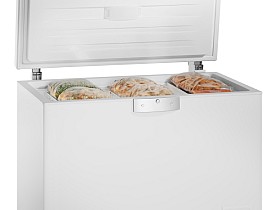Meat Freezers for Manly, Meaty People
 The local food movement is all the rage, but you will need an extra freezer to be a true “locavore” and enjoy a good steak. You can grow your own vegetables and even chickens in some cities, but your neighbors might not appreciate you raising cattle in your backyard.
The local food movement is all the rage, but you will need an extra freezer to be a true “locavore” and enjoy a good steak. You can grow your own vegetables and even chickens in some cities, but your neighbors might not appreciate you raising cattle in your backyard.
Local-food advocates say the next best thing is buying meat from your local pasture-based farm. But that often means literally buying a cow — or half a cow at least. Chances are that means buying a meat freezer.
Here are tips to help you freeze meat and buy a meat freezer.
Buying Meat to Freeze
One cubic foot of freezer space holds 35 to 40 pounds of cut, frozen and wrapped meat. The Oklahoma Cooperative Extension Service estimates that a side of beef weighs approximately 300 pounds, but roughly a quarter of that is lost to cutting and trimming. Of the remaining 225 pounds, only about 25 percent can be cooked as steaks, and 25 percent in roasts, leaving 25 percent waste and 25 percent ground beef and stew meat. The OCES advises that buying a side of beef is only cost-effective if your family plans to use all cuts of meat.
The OCES also recommends buying USDA-inspected beef from a clean, dependable supplier. Have the meat quick-frozen in a commercial freezer. Slower freezing at home can create large ice crystals and rupture the meat fibers.
Choosing an Energy-Efficient Freezer
Of course, whether you are buying a meat freezer to save money or go local, you'll want to save on electric bills by buying the most efficient model available. If you have a freezer made before 1993, you could reduce utility bills $35 per year by replacing with a new model, according to the US Department of Energy.
Chest freezers are more energy efficient than uprights because they don’t let as much cold air escape when you open the door. In addition, chest freezers typically keep food colder for longer if the power goes out.
Unlike uprights, chest freezers don't offer an automatic defrost feature (which, by the way, can double the energy use of a freezer). You'll need to defrost these models periodically. The general rule of thumb is to avoid frost buildup of more than one-quarter inch.
Finding the Best Freezer
Freezers, like many appliances, are notoriously hard to comparison-shop, with hundreds of models on the market. However, different models and even different brands are often the same freezer. Three companies make most freezers — Frigidaire makes Frigidaire, Gibson, Kenmore and GE freezers; W.C. Wood makes Amana, Magi Chef, Maytag, Danby and Whirlpool freezers; and Haier makes GE Kenmore, Maytag, Amana and Haier models. (Notice the brand overlap.)
Recommended models vary from year to year. Compare consumer ratings and reviews by Consumer Reports.
As well, take size into account. Chest freezers are available in three size ranges: compact (5-9 cubic ft.), medium (12-18 cubic ft.), and large (18+ cubic feet). Consider the volume of meat and other foods that you would like to freeze and compare that with the space you have available in your kitchen, garage, or other location where you will install the freezer.
Finally, for an environmentally friendly choice, SunDanzer makes super-efficient solar-powered chest freezers. They run on DC power, and you can hire an electrician to hook them up to a dedicated solar panel.
Updated March 19, 2018.
Looking for a Pro? Call us (866) 441-6648

Plumbing Average Costs
Plumbers Experiences

Parking Lot Lights Restored So Employees Can Reach Cars Safely

Circuit Breaker Replacement For A K9 Facility



